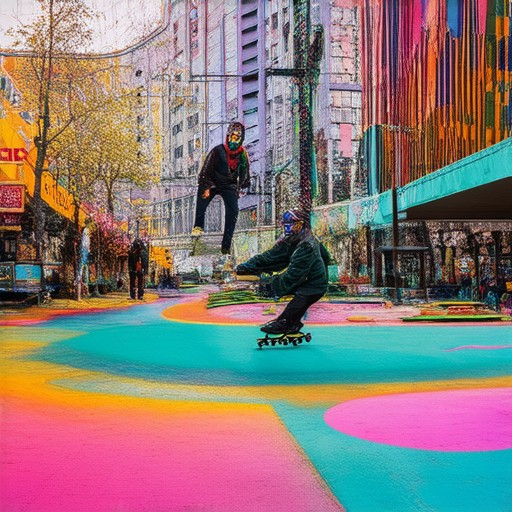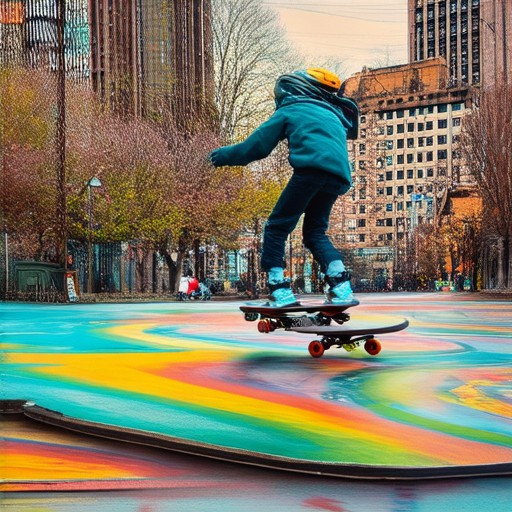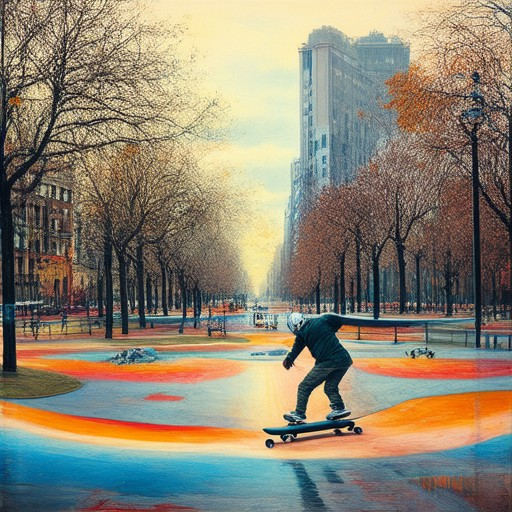Street skating versus park skating remains a hotly debated topic among skateboarders, with opinions often divided based on personal experience and preference. While both styles offer unique challenges and rewards, the question of which is inherently harder can be subjective. Street skating demands navigational prowess, as skateboarders must contend with traffic, uneven surfaces, and unpredictable obstacles in dynamic urban environments. Conversely, park skating presents its own set of hurdles, requiring precision and adaptability to master technical features like rails, gaps, and transition areas. Whether you’re a seasoned skateboarder or new to the sport, understanding these distinctions can help you appreciate the diversity of skateboarding culture and the skills it demands. From mastering street parts to navigating skatepark features, the debate continues to shape the identity of this iconic sport.

Is Street or Park Skating Harder?
Both street and park skating present unique challenges, but the difficulty depends on several factors:
- Surface Conditions: Street skating involves rough surfaces like concrete and asphalt, which can be uneven and slippery. Park skating, on the other hand, typically takes place on smoother, more consistent surfaces like wood or poured-in-place concrete.
- Technical Skill: Street skating requires quick reflexes and precise foot placement due to obstacles like curbs, drains, and traffic. Park skating also demands technical skill but often involves more varied features like rails, gaps, and transitions.
- Safety Concerns: Street skating can be riskier due to the presence of vehicles and uneven roadways. Park skating, while safer in terms of collisions, may involve higher falls or injuries from high-risk maneuvers.
- Physical Demands: Both require significant strength and endurance, but street skating may burn more calories due to the constant stopping and starting.
Ultimately, the difficulty of each style depends on personal skill level, comfort with the surface, and familiarity with the specific features. Both offer rewarding experiences and require practice to master.
Disadvantages of Skateparks
Skateparks offer a fun and vibrant space for skateboarders, BMX riders, and rollerbladers to enjoy their hobbies. However, they come with several potential downsides:
- Safety Concerns : Crowded skateparks can lead to increased risks of accidents, injuries, and collisions between different types of vehicles. The fast-paced nature of activities can escalate tensions, posing a risk to participants and bystanders alike.
- Infrastructure Costs : Building and maintaining skateparks requires significant investment in equipment and facilities. This cost is often borne by public funds or park fees, which can strain local resources and affect maintenance standards.
- Environmental Impact : The construction and upkeep of skateparks can have negative effects on the surrounding environment. Materials like concrete and asphalt contribute to heat islands and potential erosion, affecting nearby ecosystems and green spaces.
- Noise Pollution : The constant activity at skateparks generates significant noise, particularly during peak hours. This can disrupt nearby residents, especially those in urban or densely populated areas.
- Crowd Control Challenges : Managing large crowds requires adequate staffing and resources. Without proper supervision, skateparks may face issues like littering, vandalism, and unauthorized use, reducing their appeal and functionality.
- Overcrowding Risks : As skateparks grow in popularity, they may struggle to accommodate increasing numbers of users. Overcrowding can lead to stress on equipment and infrastructure, necessitating frequent repairs and upgrades.
- Social Concerns : Some skateparks may develop reputations for unsavory behavior, deterring family-friendly visits and casual users. This can limit the park’s inclusivity and community value.
- Urbanization Pressures : The rising demand for skateparks in urban areas can strain local planning and resources. Poorly designed or maintained parks may struggle to meet growing needs, leading to closures or relocations.

What Are the Two Types of Skateboarders?
Skateboarding culture encompasses a diverse range of individuals who share a passion for this unique sport and art form. While many skateboarders may seem similar in their love for the activity, they often fall into distinct categories based on their preferences, style, and the environments they choose to skate in. Here’s a breakdown of the two primary types of skateboarders:
1. Vertical Skateboarders (Vert Skaters)
Vertical skateboarding, often referred to as “vert,” is characterized by its focus on high-speed maneuvers and technical skill. These skateboarders are typically drawn to vertical structures like stairs, rails, and most notably, empty swimming pools. The transition from traditional horizontal surfaces to vertical ones requires a different approach, making vert skaters a unique group within the broader skateboarding community.
The birth of vert skateboarding is often attributed to the Z-Boys, a group of skateboarders who popularized the concept in the late 1970s. Their innovative approach to the sport led to the creation of contests like the Poolside Championships, which became iconic in the vert scene. Today, vert skating remains a niche discipline, but it continues to inspire skateboarders worldwide with its combination of athleticism and creativity.
Vert skateboarders are known for their precision, agility, and ability to execute complex tricks like ollies, kickflips, and boardslides. They often participate in competitive events, showcasing their skills in specialized venues designed specifically for vert-style riding.
2. Street Skateboarders
Street skateboarding, on the other hand, focuses on the urban environment. These skateboarders are drawn to public spaces like sidewalks, curbs, parking garages, and plazas. Street skating emphasizes adaptability and creativity, as skateboarders must navigate varied surfaces and obstacles in a dynamic city setting.
While street skating has its roots in the same grassroots movement as vert, it has evolved differently over the years. The rise of skate parks and sponsored teams brought more structure to the sport, but street skating remains a core part of skateboarding culture. Street skateboarders are often recognized for their casual, laid-back style and their ability to turn everyday objects into skateable features.
One of the key differences between street and vert skateboarders lies in their trick selection. Street skaters tend to focus on tricks like grindlines, gap jumps, and manual flips, which require a different set of skills and a different mindset compared to vert skaters. However, both types share a common appreciation for the freedom and expression that skateboarding offers.
Community and Lifestyle
Beyond the physical aspects of skateboarding, both types of skateboarders are united by a shared lifestyle. Skateboarding has become a central part of their identity, influencing their fashion, music tastes, and social interactions. Whether they’re hitting the streets or the verts, skateboarders often form tight-knit communities that celebrate the culture and its evolution over time.
Kickflip Boards encourages skateboarders of all types to explore their passions and connect with others who share their enthusiasm for the sport. Whether you’re a vert enthusiast or a street skater, there’s a place for you in the skateboarding community. Explore our resources to learn more about the latest trends, techniques, and gear that can enhance your experience on the board.
Exploring Further
If you’re curious about diving deeper into either type of skateboarding, check out our comprehensive guides and video tutorials. We’ve got resources for both vert and street skaters, covering everything from basic tricks to advanced techniques. Don’t forget to browse our shop for the latest gear and apparel to support your skateboarding journey!
Related Articles
- Types of Skateboards – Discover the different board designs perfect for your style
- Skateboard Maintenance Tips – Keep your board in top shape
- Latest Trends in Skateboarding – Stay ahead of the curve

What is a Street Part Skating?
Street part skating is a dynamic and exciting discipline within skateboarding that focuses on performing tricks on public urban surfaces. It combines creativity with technical skill, as skateboarders navigate obstacles found in city environments, such as curbs, stairs, handrails, and gaps.
Key Components of Street Part Skating:
- Course Features : Competitions often feature constructed courses with elements like rails, gaps, banked turns, and elevated platforms.
- Tricks and Skills : Skaters perform a variety of tricks, including grinds, manuals, transfers, and big air maneuvers, showcasing their ability to adapt to diverse terrain.
- Judging Criteria : Judges evaluate technical difficulty, progression, execution, and originality, with scores determining the final ranking.
Example Event Setup:
At the Paris 2024 Olympics, street part skating will take place in a designated area known as the “blaz.” Athletes will complete two 45-second runs, aiming to showcase their skills and precision.
Why Street Part Skating Matters:
This discipline highlights the evolution of skateboarding beyond private ramps, celebrating its roots in public spaces and urban culture. It emphasizes adaptability and innovation, making it a fan favorite and a thrilling spectator sport.
For more information on equipment and techniques, visit Kickflip Boards .
Is Street or Park Skating Harder?
Both street and park skating present unique challenges, making them equally difficult in their respective environments. However, the difficulty can vary based on several factors:
- Surface Type: Street skating is often considered harder due to the variety of surfaces, including asphalt, concrete, and curbs, which can make maneuvers more unpredictable. Park skating, on the other hand, typically occurs on smoother surfaces like poured-in-place concrete or wood, which can make landings and transitions more consistent.
- Obstacles: Street skating involves navigating real-world obstacles like cars, curbs, and pedestrian walkways, requiring constant awareness and quick decision-making. Park skating, while featuring designed features like rails, gaps, and bowls, requires precise control and technical skill to handle transitions and landings effectively.
- Learning Curve: Both styles demand a steep learning curve, but park skating may require more specialized tricks and technical knowledge upfront. Street skating’s unpredictability can make it harder to predict outcomes, leading to more frequent falls or collisions with stationary objects.
- Physical Demands: Street skating may place greater emphasis on endurance and adaptability due to the varied terrain and potential for longer sessions. Park skating, while technically demanding, often allows for more controlled sessions focused on specific tricks and maneuvers.
Safety gear, such as helmets and knee pads, is essential for both styles, but the specific challenges differ, making each form of skating uniquely demanding in its own right. The choice between the two ultimately depends on personal preference, skill level, and the specific environment where you’ll be skating.

Is Street or Park Skating Harder?
Both street and park skating present unique challenges, making it difficult to determine which is inherently harder. Each style of skating has its own set of conditions and requirements that can influence difficulty.
Street Skating Challenges:
- Hazards:** Street skating involves navigating traffic, uneven surfaces, and potential obstacles like curbs and potholes.
- Surface Variability:** Pavement can be smooth one day and rough the next, requiring adaptability.
- Environmental Demands:** Skaters must constantly be aware of their surroundings, including cars and pedestrians.
Park Skating Challenges:
- Technical Features:** Park skating includes features like rails, gaps, and grind boxes, which can be challenging to master.
- Surface Control:** While smoother, park surfaces can still pose challenges with features designed for trick execution.
- Falling Hazards:** Heights and transitions in parks can lead to falls, though safety measures are generally in place.
Comparison Insights:
- Surface Safety:** Street surfaces can be unpredictable, whereas park surfaces are engineered for skating.
- Skill Development:** Both require skill, but street skating may demand quicker reflexes due to traffic concerns.
- Safety Gear:** Street skaters often wear more protective gear compared to park skaters.
Conclusion:
Neither street nor park skating is definitively harder. The difficulty depends on the environment, surface conditions, and individual skill levels. Choosing between the two should be based on personal preference, local infrastructure, and comfort with the specific challenges each setting presents.




0 Comments